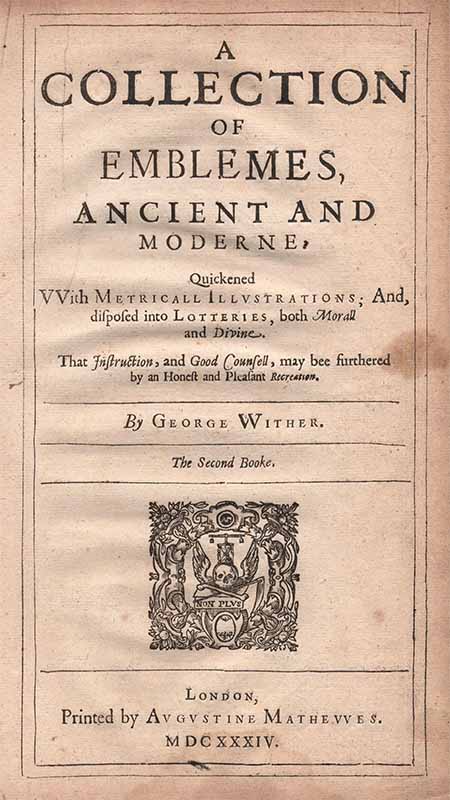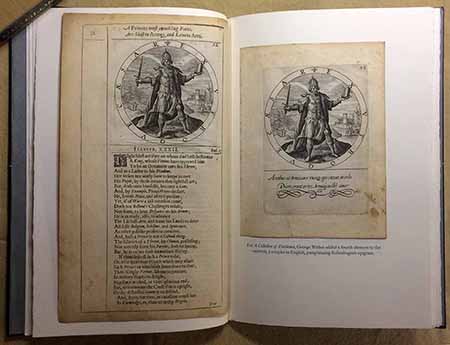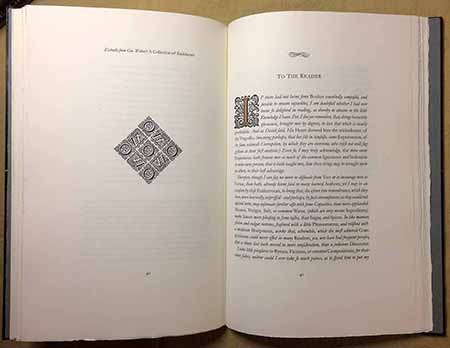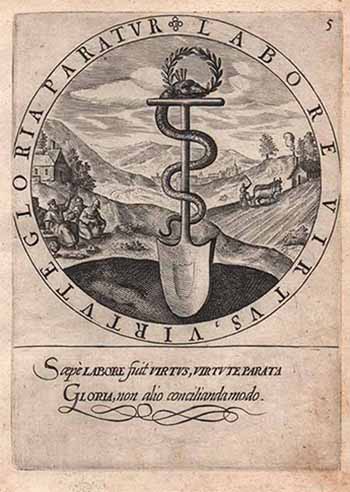George Wither’s A Collection of Emblemes Ancient & Moderne shares the milestone for first emblem book printed in England with his contemporary, Francis Quarles. Wither’s book, however, is distinguished by, among other features, the quality of its copper-plate engravings, the same plates commissioned two decades earlier from Crispin van de Passe, for Gabriel Rollenhagen’s Nucleus Emblematum Selectissimorum (1611). Labour Vertue Glorie presents leaves from both books, side by side, illustrating the technical, physical, and conceptual similarities and differences.
Although the history and elements of emblems pre-date the Renaissance, the most commonly recognized form – an image, a motto, and an epigram, which combined make the emblem – appeared in Andrea Alciato’s Emblematum Liber (1531). The form flourished through the 16th century, but was already considered somewhat old-fashioned by the time Wither and Quarles wrote their books. Enough time had passed by the late 19th century for emblems to be rediscovered, and they have since become a field of lively academic study.
The focus of Labour Vertue Glorie, however, is not the content or interpretations of the two authors’ emblems, but the production and form of the books from which these sample leaves come. To that end, the book reprints three of Wither’s prefatory notes from A Collection: one about William Marshall’s engraved frontispiece, one about the game of lots included in the book, and “To The Reader” in which he discusses at length the book’s creation and intent. Each of these is appended with comments from a variety of sources, discussing and sometimes disputing the author’s words. The comments also provide some insights to how Wither adopted, and more importantly adapted, Rollenhagen’s original work for his own purposes. While not exact facsimiles, the reprinted texts follow the original’s use of swash characters and seemingly random combinations of roman, italic, and majuscule types. But only the reprinted texts; the rest of the book is set in a more traditional, and calming, manner.
In addition to Wither’s introductory remarks, Labour Vertue Glorie includes brief biographies of Rollenhagen and Wither; some bibliographic details about the two emblem books; a history of Augustine Mathewes, the printer of A Collection; and the tangled story of Wither’s protracted patent dispute with the Stationers’ Company, and how it relates to the publication of A Collection of Emblemes. Engraved portraits of both authors are reproduced, along with facsimile settings of an emblem (i.e. page) each from Alciato’s Emblematum Liber and Quarles’ Emblemes. The book concludes with a facsimile of the leaf at the end of A Collection, with the two boards for playing his game of lots, complete with spinners and Wither's directions for playing. Thus, anyone feeling the need can easily find one of the facsimile or digital versions of A Collection of Emblemes available, and play the game.
Labour Vertue Glorie (8 x 12 inches, approx. 68 pages) is set in Monotype Garamond (several sizes) on a page slightly larger than Wither’s quarto. Like the books from which the leaves came, the type was inked and printed by hand, with a handpress, on dampened paper (Arches Text wove and Golden Hind laid). A number of decorative initial letters taken from A Collection are incorporated to the setting, along with various patterns made up from the single printer's flower used in that book. In Series 1 and 2 Copies, the initial letters were illuminated by hand in bronze (a total of nine per copy). Elaborate flourishes from the engraved calligraphic mottoes on de Passe’s plates (sadly cut away for Wither’s book) adorn the top of chapter openings.
Aside from brief preliminary material (& translations), Rollenhagen’s book is entirely intaglio, printed rectos only. Wither’s book combines the intaglio plates with extensive letterpress on each page, and is printed on both sides; thus, one Wither leaf presents two emblems (recto and verso), while one Rollenhagen leaf presents one emblem (recto only). With the different formats in mind, Labour Vertue Glorie was published in an edition of 48 copies, in three states.
SERIES 1: Copies 1‒16 with leaves containing the same emblems from Rollenhagen and Wither (i.e. two Rollenhagen leaves bookending a Wither leaf, presenting the same plate from each book side by side, as illustrated above), to allow for comparing the state and printing of the same plates. Also included is a text leaf, from the preliminary notes and dedications in Wither’s book, as a frontis. These copies were bound by Claudia Cohen: sewn on vellum slips, laced through a vellum spine and cased with Karli Frigge's marbled papers over boards. By advance subscription, copies could be extra-bound in vellum and leather, with a clamshell box and additional emblem leaf from Wither's book inserted opposite the colophon. Copies 1‒7 were bound thus. [OP]
SERIES 2: Copies 17‒23 with a leaf from Rollenhagen paired with the same plate on a Wither leaf (recto or verso, as the case may be), bound in quarter vellum and Karli Frigge's marbled papers by Claudia Cohen. [OP]
SERIES 3: Copies 24‒48 with a leaf from both Rollenhagen and Wither (different emblems). Cased in printed paper over boards, with a printed paper vellum spine, at the HM studio. $900
The leaves for this publication came from broken and incomplete copies, and to greater or lesser degrees, it shows. Some of the Rollenhagen leaves have minor staining or foxing around the edges, and some of the Wither pages are slightly worn or frayed at the edges. All leaves are complete. The sample leaves will be integral to the book, the Rollenhagen leaves tipped in, the Wither leaves attached to a stub and then sewn in, to allow for easy inspection of both sides.




